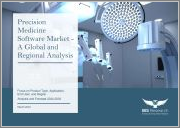
|
시장보고서
상품코드
1619210
세계의 정밀의료 소프트웨어 시장 - 규모, 점유율, 성장 분석(제공 방법별, 용도별, 최종 사용자별, 지역별) : 산업 예측(2024-2031년)Precision Medicine Software Market Size, Share, Growth Analysis, By Delivery Mode (Web & Cloud-Based, On-Premises), By Application (Oncology, Pharmacogenomics), By End User, By Region - Industry Forecast 2024-2031 |
||||||
세계 정밀의료 소프트웨어 시장 규모는 2022년에 13억 1,000만 달러로 평가되었고, 2023년 14억 8,000만 달러에서 2031년에는 38억 1,000만 달러로 성장해 예측 기간(2024-2031) 년)의 CAGR은 12.6%에서 발전할 전망입니다.
세계의 정밀의료 소프트웨어 시장은 기술의 진보와 개별화된 의료 솔루션에 대한 수요 증가에 힘입어 빠르게 진화하고 있습니다. 유전, 환경, 라이프스타일의 변화를 고려하여 커스터마이즈된 치료계획을 가능하게 합니다. 유전체학와 단백질체학의 진보, 전자 의료 기록의 보급 확대, 정부의 지원 정책 등을 들 수 있습니다. 전반적인 동향은 환자의 결과를 최적화하는 맞춤형 의료 접근법으로의 전환을 강조합니다.
목차
소개
- 분석 목적
- 시장 범위
- 정의
분석 기법
- 정보 조달
- 2차·1차 데이터의 수법
- 시장 규모 예측
- 시장의 상정과 제약
주요 요약
- 시장 개요와 전망
- 수급 동향의 분석
- 부문별 기회 분석
시장 역학과 전망
- 시장 개요
- 시장 규모
- 시장 역학
- 성장 촉진요인과 기회
- 억제요인과 과제
- Porter's Five Forces 분석과 영향
- 경쟁 기업간 경쟁 관계
- 대체품의 위협
- 구매자의 협상력
- 신규 참가업체의 위협
- 공급기업의 협상력
시장의 주요 고려사항
- 주요 성공 요인
- 경쟁도
- 주요 투자 기회
- 시장 생태계
- 시장 매력도 지수(2023년)
- PESTEL 분석
- 거시경제지표
- 밸류체인 분석
- 가격 분석
- 기술진보
- 규제 상황
- 특허 분석
- 사례 연구
세계의 정밀의료 소프트웨어 시장 규모·CAGR: 제공 방법별(2024-2031년)
- 시장 개요
- Web·클라우드 베이스
- 온프레미스
세계의 정밀의료 소프트웨어 시장 규모·CAGR: 용도별(2024-2031년)
- 시장 개요
- 종양학
- 약리 유전체학(약물유전체학)
- 희소질환
세계의 정밀의료 소프트웨어 시장 규모·CAGR: 최종 사용자별(2024-2031년)
- 시장 개요
- 의료 제공업체
- 연구센터 및 학술기관
- 제약·바이오테크놀러지 기업
세계의 정밀의료 소프트웨어 시장 규모·CAGR(2024-2031년)
- 북미
- 미국
- 캐나다
- 유럽
- 영국
- 독일
- 스페인
- 프랑스
- 이탈리아
- 기타 유럽
- 아시아태평양
- 중국
- 인도
- 일본
- 한국
- 기타 아시아태평양
- 라틴아메리카
- 브라질
- 기타 라틴아메리카
- 중동 및 아프리카
- GCC 국가
- 남아프리카
- 기타 중동 및 아프리카
경쟁 정보
- 상위 5개사 비교
- 주요 기업의 시장 포지셔닝(2023년)
- 주요 시장 기업이 채용한 전략
- 시장의 최근 동향
- 기업의 시장 점유율 분석(2023년)
- 주요 기업의 기업 프로파일
- 기업 개요
- 제품 포트폴리오 분석
- 부문별 점유율 분석
- 수익의 전년 대비 비교(2021-2023)
주요 기업 프로파일
- IBM Watson Health
- Oracle Corporation
- SAP SE
- SAS Institute Inc.
- Microsoft Corporation
- Flatiron Health, Inc.
- Syapse, Inc.
- Fabric Genomics, Inc.
- N-of-One, Inc.
- Gene42, Inc.
- PierianDx
- LifeOmic
- Tempus Labs, Inc.
- 2bPrecise LLC
- Human Longevity, Inc.
- GNS Healthcare
- Seven Bridges Genomics
- WuXi NextCODE
- Foundation Medicine, Inc.
- Strand Life Sciences
결론과 권장사항
JHS 25.01.14Global Precision Medicine Software Market size was valued at USD 1.31 billion in 2022 and is poised to grow from USD 1.48 billion in 2023 to USD 3.81 billion by 2031, growing at a CAGR of 12.6% during the forecast period (2024-2031).
The global precision medicine software market is rapidly evolving, fueled by technological advancements and a growing demand for personalized healthcare solutions. This software empowers healthcare providers to analyze extensive patient data, enabling customized treatment plans that account for genetic, environmental, and lifestyle variations. Key drivers of market expansion include the rising incidence of chronic diseases, advancements in genomics and proteomics, a growing adoption of electronic health records, and supportive government policies. Additionally, the incorporation of artificial intelligence and machine learning algorithms is poised to enhance the capabilities of precision medicine software, further propelling market growth in the near future. The overall trend underscores a transformative shift towards tailored healthcare approaches, optimizing patient outcomes.
Top-down and bottom-up approaches were used to estimate and validate the size of the Global Precision Medicine Software market and to estimate the size of various other dependent submarkets. The research methodology used to estimate the market size includes the following details: The key players in the market were identified through secondary research, and their market shares in the respective regions were determined through primary and secondary research. This entire procedure includes the study of the annual and financial reports of the top market players and extensive interviews for key insights from industry leaders such as CEOs, VPs, directors, and marketing executives. All percentage shares split, and breakdowns were determined using secondary sources and verified through Primary sources. All possible parameters that affect the markets covered in this research study have been accounted for, viewed in extensive detail, verified through primary research, and analyzed to get the final quantitative and qualitative data.
Global Precision Medicine Software Market Segmental Analysis
Global Precision Medicine Software Market is segmented by delivery mode, application, end user and region. Based on delivery mode, the market is segmented into web & cloud-based and on-premises. Based on application, the market is segmented into oncology, pharmacogenomics and rare diseases. Based on end user, the market is segmented into healthcare providers, research centers and academic institutes and pharmaceutical and biotechnology Companies. Based on region, the market is segmented into North America, Europe, Asia Pacific, Latin America and Middle East & Africa.
Driver of the Global Precision Medicine Software Market
A significant driver of the global precision medicine software market is the rising demand for personalized healthcare solutions. As precision medicine focuses on delivering customized treatments tailored to an individual's unique genetic profile, lifestyle, and environmental influences, the need for corresponding software has surged. Technological advancements in genomic sequencing and big data analytics have made it easier to incorporate precision medicine into healthcare practices. This software allows providers to sift through extensive patient data, including genetic and medical histories, along with real-time monitoring, enabling more personalized treatment decisions. Growing awareness among patients and healthcare professionals about precision medicine's benefits continues to amplify the demand for supporting software solutions.
Restraints in the Global Precision Medicine Software Market
The global precision medicine software market faces significant restraints primarily due to the complexity and high costs involved in implementation and integration. This field necessitates the handling of vast amounts of genomic and clinical data, which requires sophisticated software systems capable of accurate analysis. However, healthcare organizations often encounter challenges, including interoperability issues and data privacy concerns, which complicate the integration process. Moreover, the extensive training required for healthcare professionals adds another layer of difficulty. High acquisition, maintenance, and upgrading costs further deter smaller healthcare institutions or those in resource-limited areas, hindering their capacity to adopt these advanced medical technologies.
Market Trends of the Global Precision Medicine Software Market
The global precision medicine software market is currently experiencing transformative trends that are reshaping healthcare delivery. A notable trend is the rising incorporation of artificial intelligence (AI) and machine learning (ML) technologies, which enhance diagnostic accuracy and facilitate the development of tailored treatment plans, ultimately leading to improved patient outcomes. Additionally, the increased embrace of cloud-based platforms is driving the secure, efficient storage and analysis of vast genomic and clinical datasets, further streamlining workflows. Moreover, a strong emphasis on interoperability and data standardization is fostering better integration among disparate healthcare systems, promoting collaboration among providers. Collectively, these trends are accelerating the adoption of precision medicine software, positioning it as a cornerstone of modern healthcare solutions.
Table of Contents
Introduction
- Objectives of the Study
- Scope of the Report
- Definitions
Research Methodology
- Information Procurement
- Secondary & Primary Data Methods
- Market Size Estimation
- Market Assumptions & Limitations
Executive Summary
- Global Market Outlook
- Supply & Demand Trend Analysis
- Segmental Opportunity Analysis
Market Dynamics & Outlook
- Market Overview
- Market Size
- Market Dynamics
- Driver & Opportunities
- Restraints & Challenges
- Porters Analysis & Impact
- Competitive rivalry
- Threat of substitute
- Bargaining power of buyers
- Threat of new entrants
- Bargaining power of suppliers
Key Market Insights
- Key Success Factors
- Degree of Competition
- Top Investment Pockets
- Market Ecosystem
- Market Attractiveness Index, 2023
- PESTEL Analysis
- Macro-Economic Indicators
- Value Chain Analysis
- Pricing Analysis
- Technological Advancement
- Regulatory Landscape
- Patent Analysis
- Case Studies
Global Precision Medicine Software Market Size by Delivery Mode & CAGR (2024-2031)
- Market Overview
- Web & Cloud-Based
- On-Premises
Global Precision Medicine Software Market Size by Application & CAGR (2024-2031)
- Market Overview
- Oncology
- Pharmacogenomics
- Rare Diseases
Global Precision Medicine Software Market Size by End User & CAGR (2024-2031)
- Market Overview
- Healthcare Providers
- Research Centers and Academic Institutes
- Pharmaceutical and Biotechnology Companies
Global Precision Medicine Software Market Size & CAGR (2024-2031)
- North America (Delivery Mode, Application, End User)
- US
- Canada
- Europe (Delivery Mode, Application, End User)
- UK
- Germany
- Spain
- France
- Italy
- Rest of Europe
- Asia-Pacific (Delivery Mode, Application, End User)
- China
- India
- Japan
- South Korea
- Rest of Asia Pacific
- Latin America (Delivery Mode, Application, End User)
- Brazil
- Rest of Latin America
- Middle East & Africa (Delivery Mode, Application, End User)
- GCC Countries
- South Africa
- Rest of Middle East & Africa
Competitive Intelligence
- Top 5 Player Comparison
- Market Positioning of Key Players, 2023
- Strategies Adopted by Key Market Players
- Recent Developments in the Market
- Company Market Share Analysis, 2023
- Company Profiles of All Key Players
- Company Details
- Product Portfolio Analysis
- Company's Segmental Share Analysis
- Revenue Y-O-Y Comparison (2021-2023)
Key Company Profiles
- IBM Watson Health
- Company Overview
- Business Segment Overview
- Financial Updates
- Key Developments
- Oracle Corporation
- Company Overview
- Business Segment Overview
- Financial Updates
- Key Developments
- SAP SE
- Company Overview
- Business Segment Overview
- Financial Updates
- Key Developments
- SAS Institute Inc.
- Company Overview
- Business Segment Overview
- Financial Updates
- Key Developments
- Microsoft Corporation
- Company Overview
- Business Segment Overview
- Financial Updates
- Key Developments
- Flatiron Health, Inc.
- Company Overview
- Business Segment Overview
- Financial Updates
- Key Developments
- Syapse, Inc.
- Company Overview
- Business Segment Overview
- Financial Updates
- Key Developments
- Fabric Genomics, Inc.
- Company Overview
- Business Segment Overview
- Financial Updates
- Key Developments
- N-of-One, Inc.
- Company Overview
- Business Segment Overview
- Financial Updates
- Key Developments
- Gene42, Inc.
- Company Overview
- Business Segment Overview
- Financial Updates
- Key Developments
- PierianDx
- Company Overview
- Business Segment Overview
- Financial Updates
- Key Developments
- LifeOmic
- Company Overview
- Business Segment Overview
- Financial Updates
- Key Developments
- Tempus Labs, Inc.
- Company Overview
- Business Segment Overview
- Financial Updates
- Key Developments
- 2bPrecise LLC
- Company Overview
- Business Segment Overview
- Financial Updates
- Key Developments
- Human Longevity, Inc.
- Company Overview
- Business Segment Overview
- Financial Updates
- Key Developments
- GNS Healthcare
- Company Overview
- Business Segment Overview
- Financial Updates
- Key Developments
- Seven Bridges Genomics
- Company Overview
- Business Segment Overview
- Financial Updates
- Key Developments
- WuXi NextCODE
- Company Overview
- Business Segment Overview
- Financial Updates
- Key Developments
- Foundation Medicine, Inc.
- Company Overview
- Business Segment Overview
- Financial Updates
- Key Developments
- Strand Life Sciences
- Company Overview
- Business Segment Overview
- Financial Updates
- Key Developments
















